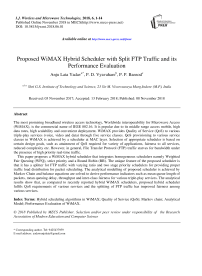Proposed WiMAX hybrid scheduler with split FTP traffic and its performance evaluation
Автор: Anju Lata Yadav, P. D. Vyavahare, P. P. Bansod
Журнал: International Journal of Wireless and Microwave Technologies @ijwmt
Статья в выпуске: 6 Vol.8, 2018 года.
Бесплатный доступ
The most promising broadband wireless access technology, Worldwide interoperability for Microwave Access (WiMAX), is the commercial name of IEEE 802.16. It is popular due to its middle range access mobile, high data rates, high scalability and convenient deployment. WiMAX provides Quality of Service (QoS) to various triple-play services (voice, video and data) through five service classes. QoS provisioning to various service classes in WiMAX is achieved by a scheduler at MAC layer. Selection of appropriate scheduler is based on certain design goals, such as attainment of QoS required for variety of applications, fairness to all services, reduced complexity etc. However, in general, File Transfer Protocol (FTP) traffic starves for bandwidth under the presence of high priority real-time traffic. This paper proposes a WiMAX hybrid scheduler that integrates homogeneous schedulers namely Weighted Fair Queuing (WFQ), strict priority and a Round Robin (RR). The unique feature of the proposed scheduler is that it has a splitter for FTP traffic with varying ratio and two stage priority schedulers for providing proper traffic load distribution for packet scheduling. The analytical modelling of proposed scheduler is achieved by Markov Chain and balance equations are solved to derive performance indicators such as mean queue length of packets, mean queuing delay, throughput and inter-class fairness for various triple-play services. The analytical results show that, as compared to recently reported hybrid WiMAX schedulers, proposed hybrid scheduler fulfils QoS requirements of various services and the splitting of FTP traffic has improved fairness among various services.
Hybrid scheduling algorithms in WiMAX, Quality of Service (QoS), Markov chain, Analytical Model, Performance Evaluation of WiMAX
Короткий адрес: https://sciup.org/15016947
IDR: 15016947 | DOI: 10.5815/ijwmt.2018.06.01
Список литературы Proposed WiMAX hybrid scheduler with split FTP traffic and its performance evaluation
- So-In C, Jain R, and Tamimi A K. “Scheduling in IEEE 802.16e Mobile WiMAX Networks: Key Issues and a Survey”, IEEE Journal On selected Areas in Communications 2009; 27(2): 56-171.
- Nuaymi L (2007) Wi-MAX Technology for Broadband Wireless Access. John Wiley and Sons Ltd.
- Yadav A, Vyavahare P D, and Bansod P P. “Review of WiMAX Scheduling Algorithms and their Classification, Journal of Institution of Engineers”, India, series B (Springer) 2015; 96(2): 197-208.
- Shrivastava A, Bansod P, Gupta K, and Merchant S N. “An improved multicast based energy efficient opportunistic data scheduling algorithm for VANET”, AEU-International Journal of Electronics and Communications 2018; 83 : 407-415.
- Andrews Jeffrey G., Ghosh A. and Muhamed R. (2007) Fundamentals of WiMAX: Understanding Broadband Wireless Networking, 1st ed., Prentice Hall, USA.
- Taghipoor M, MJafari S. and Hosseini V. (2012) Scheduling Algorithm and Bandwidth Allocation in WiMAX. In Quality of Service and Resource Allocation in WiMAX. Open access peer-reviewed chapter edited by Dr. Roberto Hincapie, InTech.
- Nandhini R, and Devarajan N. “Comparison for WiMAX Scheduling Algorithms and Proposal Quality Of Service Improvement in WiMAX Network”, American Journal of Applied Sciences 2014; 11(1): 8-16.
- Wang L, Min G, Kouvatsos D D, and Jin X. “Analytical Modeling of an Integrated Priority and WFQ Scheduling scheme in Multi Service Networks”, Journal of Computer communications 2010; 33(11): 93-101.
- Yadav A, Vyavahare P D, and Bansod P P. “An Improved Hybrid Scheduler for WiMAX and its Performance Evaluation”. International Conference on Networking and Service (ICNS), Chamonix, France, April 2014: 84- 89.
- Jin X, and Min G. “Modeling and analysis of priority queuing systems with multi-class self-similar network traffic: a novel and efficient queue-decomposition approach”, IEEE Transactions on Communications 2009; 57 (5) :1444–1452.
- Noordin K A, and Markarian G. “Providing QoS Support through Scheduling in WiMAX Systems”. International Journal of the Physical Sciences 2011; 6 (16): 4070-4081.
- Kafhali S El, and Hanini M. “Stochastic Modeling and Analysis of Feedback Control on the QoS VoIP Traffic in a single cell IEEE 802.16e Networks”. International Journal of Computer Science 2017; 44(1): 19-28.
- Ahmed Z, and Hamma S. “Analytical model of two level scheduling algorithm for WiMAX networks”. International Conference on Wireless Networks and Mobile Communications (WINCOM), Marrakech, Morocco, Oct 2015.
- Grover P, and Teixeira A M. “A New Queue Length based Scheduling Strategy for nrtPS Service Class in IEEE 802.16 Networks”. 13th International Conference on Wireless Networks and Mobile Systems (WINSYS), Lisbon, Portugal, July 2016.
- Sreenivasulu U., Naganjaneyulu P.V., and Giriprasad M.N. “Downlink Scheduling Algorithm for WiMAX Protocol to Improve QoS”. Arab Journal of Science and Engineering, 2017 https://doi.org/10.1007/s13369-017-2717-6.
- Dhrona P, Abu Ali Najah, and Hassanein H. “A Performance study of Uplink scheduling Algorithms in point to Multipoint WiMAX Networks”, Journal of Computer Communication 2009; 32(3): 511-52.
- Hossein P N. Introduction to Probability, Statistics, and Random Processes. Kappa Research, 2014.
- Jain R, Chiu D M, and Hawe W. “A Quantitative Measure of Fairness and Discrimination for Resource Allocation in Shared Computer Systems”. DEC Research Report TR-301 1984.
- Aejandro Q, Yacine E, and Samuel P. “Performance evaluation of a broadband wireless access system subjected to heavy load”. Journal of Computer Communication 2004; 27: 781-79.
- Karandikar A, and Salodkar N. “Cross Layer Scheduling in Wireless Networks”, in: Kennington Jeff, Olinick El, Rajan Dinesh (Eds.), Wireless Network Design: Optimization Models and Solutions Procedures, Springer- Verlag 2010.


